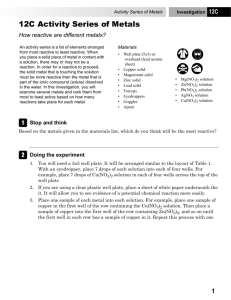
- Chemlab 10 activities of metals pro#
- Chemlab 10 activities of metals series#
- Chemlab 10 activities of metals free#
Group IA and Ammonium compounds are soluble.Ĭhlorides, Bromides and Iodides are soluble. The solubility behavior of the ions that you will be using is summarized in the following table:

Chemlab 10 activities of metals free#
The last five metals (mercury - gold) are often found free in nature, their oxides decompose with mild heating, and they form oxides only indirectly.\] The metals lithium - copper, can combine directly with oxygen to form the oxide. Their oxides undergo reduction by heating with H2, carbon, and carbon monoxide. The most important heavy metals that can be and have been used as poisons are lead (Pb), mercury (Hg), arsenic (As), cadmium (Cd), and iron (Fe).

It is designed to help students link chemical computations with authentic laboratory chemistry. Heavy metals are transition metals found in the middle of the periodic table that are of environmental or physiological concern. The next six metals (iron - lead) replace hydrogen from HCl and dil. Study with Quizlet and memorize flashcards containing terms like Purpose, what are the most common metals ranked on, Only the most reactive metals are able. The Virtual Lab is an online simulation of a chemistry lab. It was in fact the alchemists who first demonstrated conclusively that the metals were not actually consumed, but remained in the solution in the form of atoms. The oxides of all of these first metals resist reduction by H2. many earlier natural philosophers assumed that the metal was consumed in the process. The next four metals (magnesium - chromium) are considered active metals and they will react with very hot water or steam to form the oxide and hydrogen gas. The first five elements (lithium - sodium) are known as very active metals and they react with cold water to produce the hydroxide and hydrogen gas. College level ready in Reading Course Description This course is for non-science majors.
Chemlab 10 activities of metals pro#
Free radical activity and pro - inflammatory effects of particulate air pollution ( PM10 ) in vivo and in vitro. Materials To perform this experiment, students used a test tube rack, two micro test tubes, a 50mL graduated cylinder, two 150mL beakers, a stirring rod, a 10cm plastic tube, a DC voltmeter, and a 15-cm copper wire cables with alligator clips. The larger the interval between elements, the more vigorous the reaction. Li XY, Gilmour PS, Donaldson K, MacNee W.

2 B shows the polarization curves of Ni MOF, Zn MOF, and NiZn MOF. The ORR activities of the catalysts were tested using polarization curves at a scan rate of 10 mV/s.
Chemlab 10 activities of metals series#
Activity Series of Metals Each element on the list replaces from a compound any of the elements below it. Brass: a metal alloy made of copper and zinc the proportions of zinc and copper can be varied. Metalorganic framework (MOF) catalysts with porous structures have been used for the electrosynthesis of H 2 O 2 in the oxygen reduction reaction.LEO the lion says GER ! ose lectrons xidation ain lectrons Eduction GER! Oxidation and Reduction.Analysis of the Single Replacement Reaction 1 p 1 p 1 e- 1 e- 12 p 17 p 12 e- 18 e- 1 p 17 p 0 e- 18 e- 12 p 12 e- H atoms sharing a pair of e- in nonpolar covalent bonds Mg 2+ & Cl - ions in solution by ion-dipole attractions H+ and Cl- ions in solution by ion-dipole attractions Atoms held in fixed positions by metallic bonds + H 2 (g) MgCl 2 (aq) HCl (aq) Mg(s) + PRODUCTS REACTANTS.


 0 kommentar(er)
0 kommentar(er)
